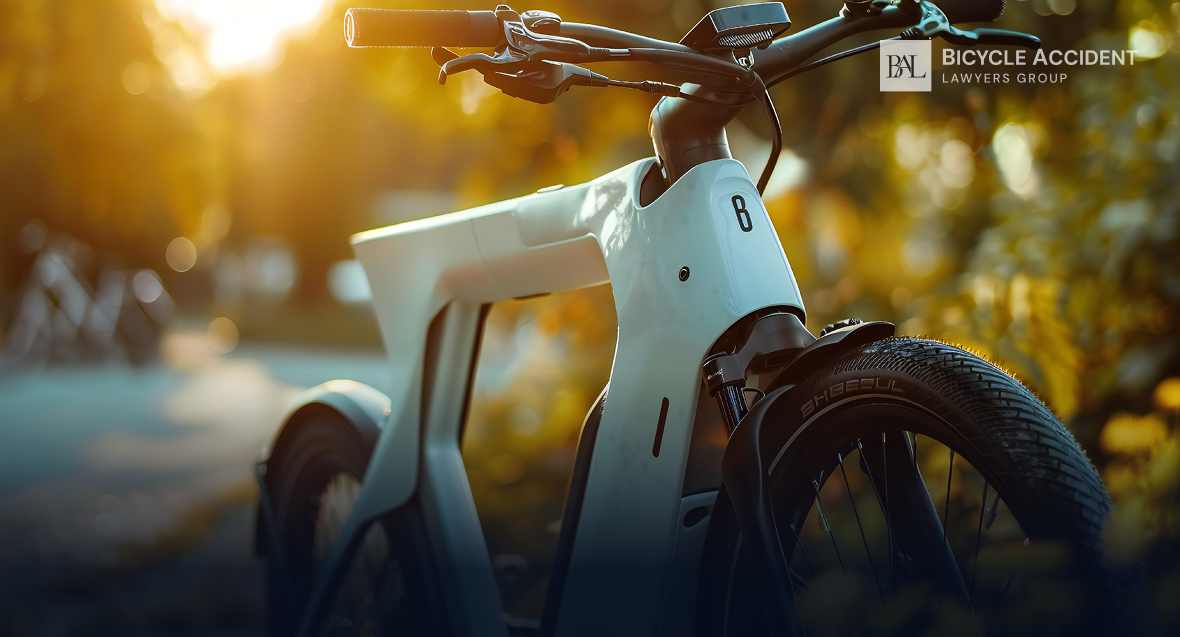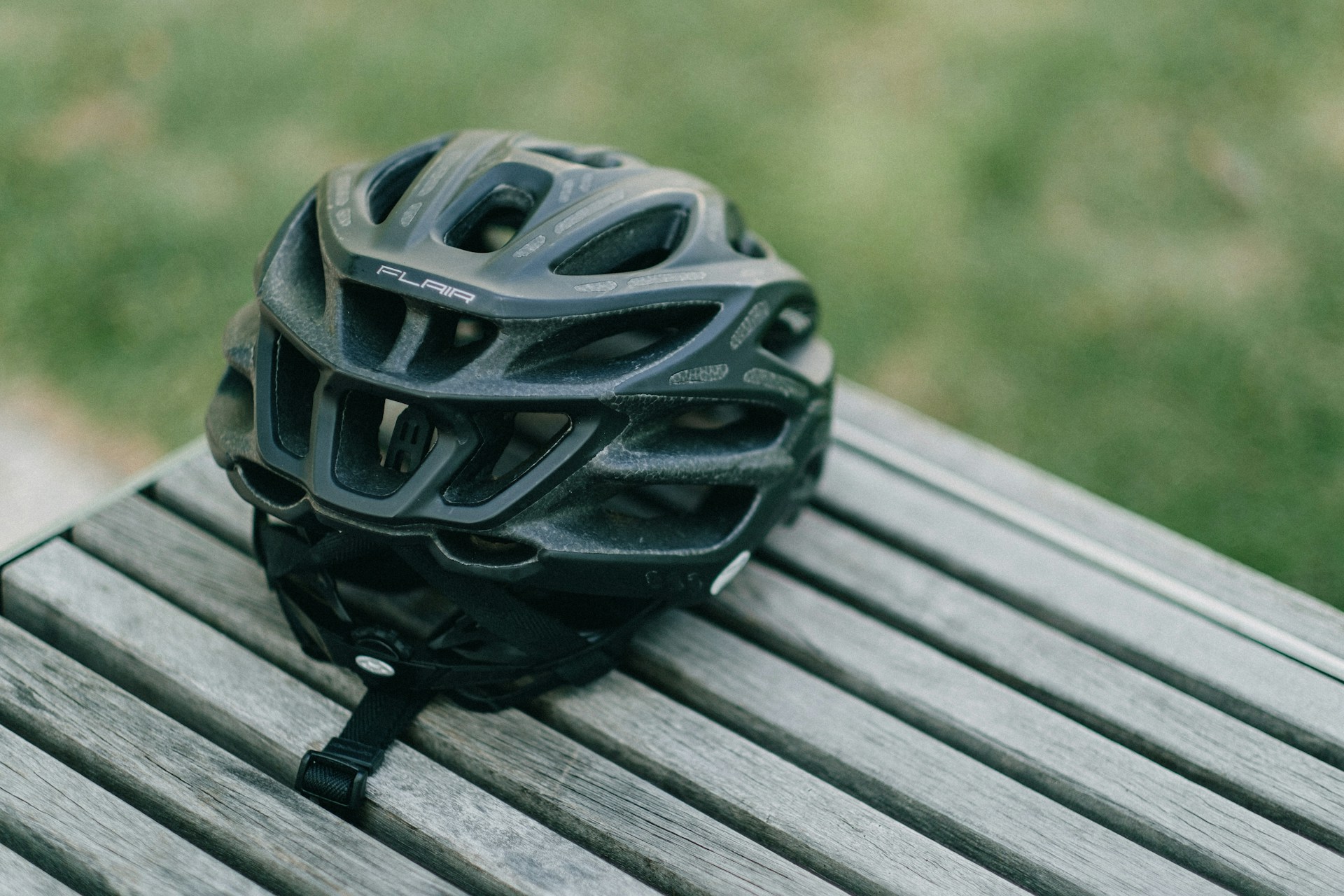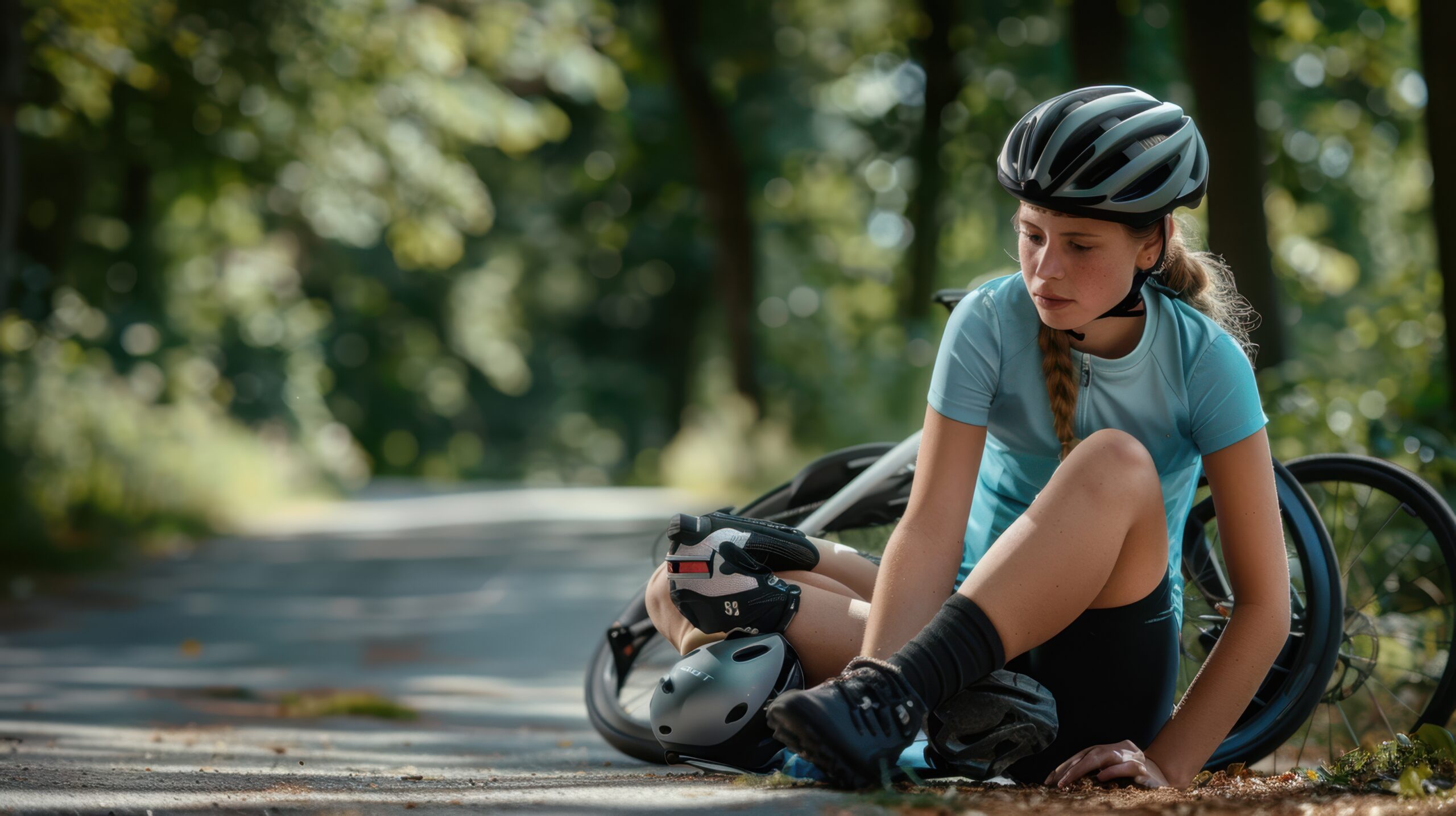New York City is known for its versatile transportation scene. People use various means to get from one place to another across the city and the state. However, if cars, public transport, and good old bicycles are referred to as classy options, there’s been a new addition to the pool — electric bikes. Unlike traditional bicycles, e-bikes seem to have countless perks to benefit from. Their accessibility, speed, and affordability can convince anyone to switch from a motor vehicle or a classy bicycle to an innovative electric bike.
However, recent New York bicycle accident statistics prove that electric bicycles aren’t entirely safe. 22 people were fatally injured over the course of three years, from 2020 to 2023. Thus, practicality and fun come with a few critical responsibilities if you want to avoid creating a dangerous road situation and getting seriously injured as a result.
When riding an electric bicycle, you should:
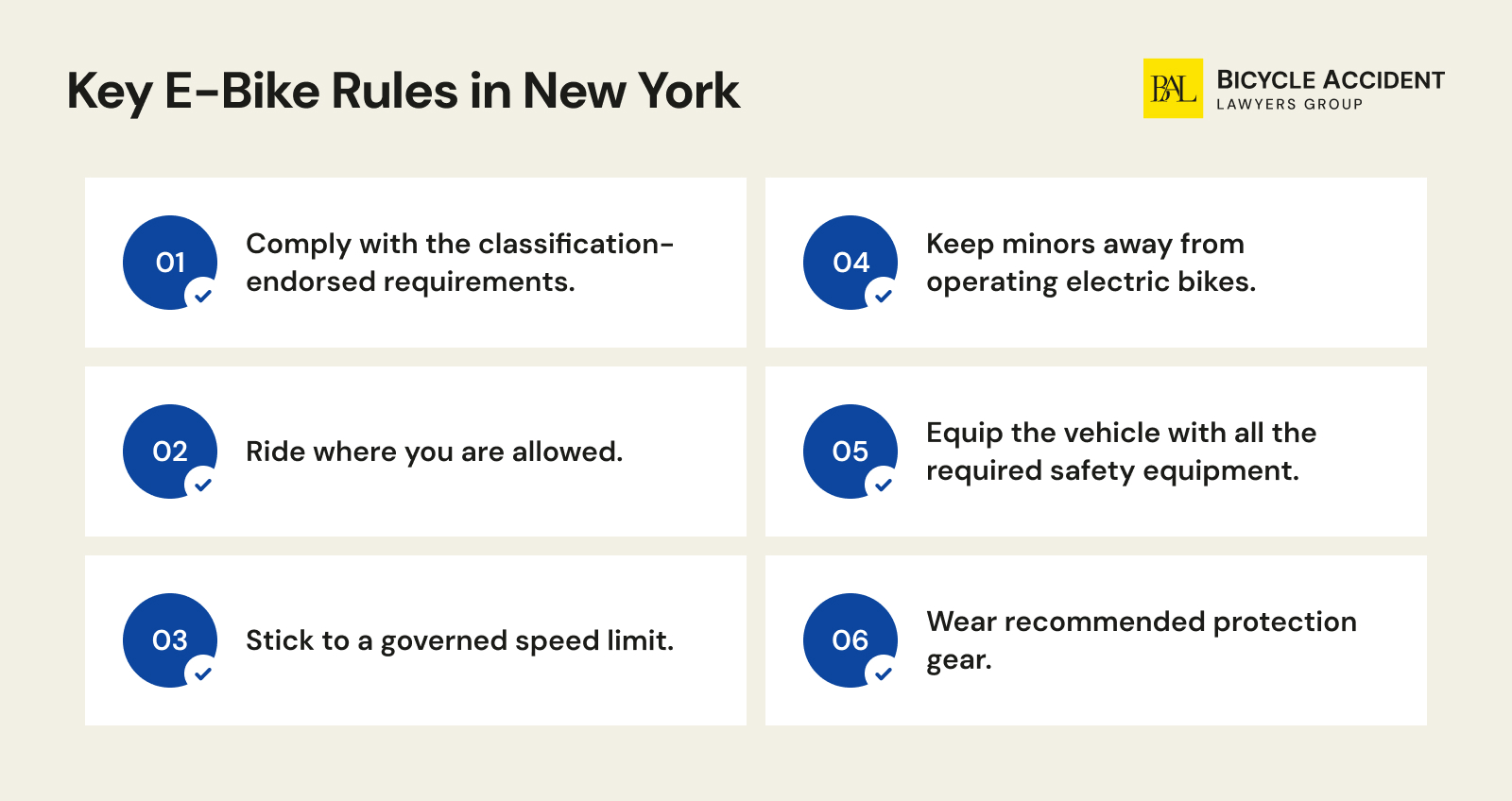
- Comply with the classification-endorsed requirements.
- Ride where you are allowed.
- Stick to a governed speed limit.
- Keep minors away from operating electric bikes.
- Equip the vehicle with all the required safety equipment.
- Wear recommended protection gear.
Definition of an Electric Bike in New York
So what exactly is an electric bicycle, you may wonder? Well, New York State has a legal definition for this type of vehicle. Simply put, it is a two-wheeled bicycle equipped with an electric motor but has operable pedals. There are a few different subcategories of electric bikes based on whether they use a throttle or pedal assist.
The state also has a specific requirement for the motor that the vehicle is equipped with — its power should not exceed 750 watts. Major electric bike laws and speed limits apply to electric bicycles. E-bikes aren’t classified as motor vehicles in New York, but they give biker riders an additional boost and make it a lot easier to travel longer distances and harsher terrains.
Electric Bikes & Mopeds in NYC: Categories and Vital Specs
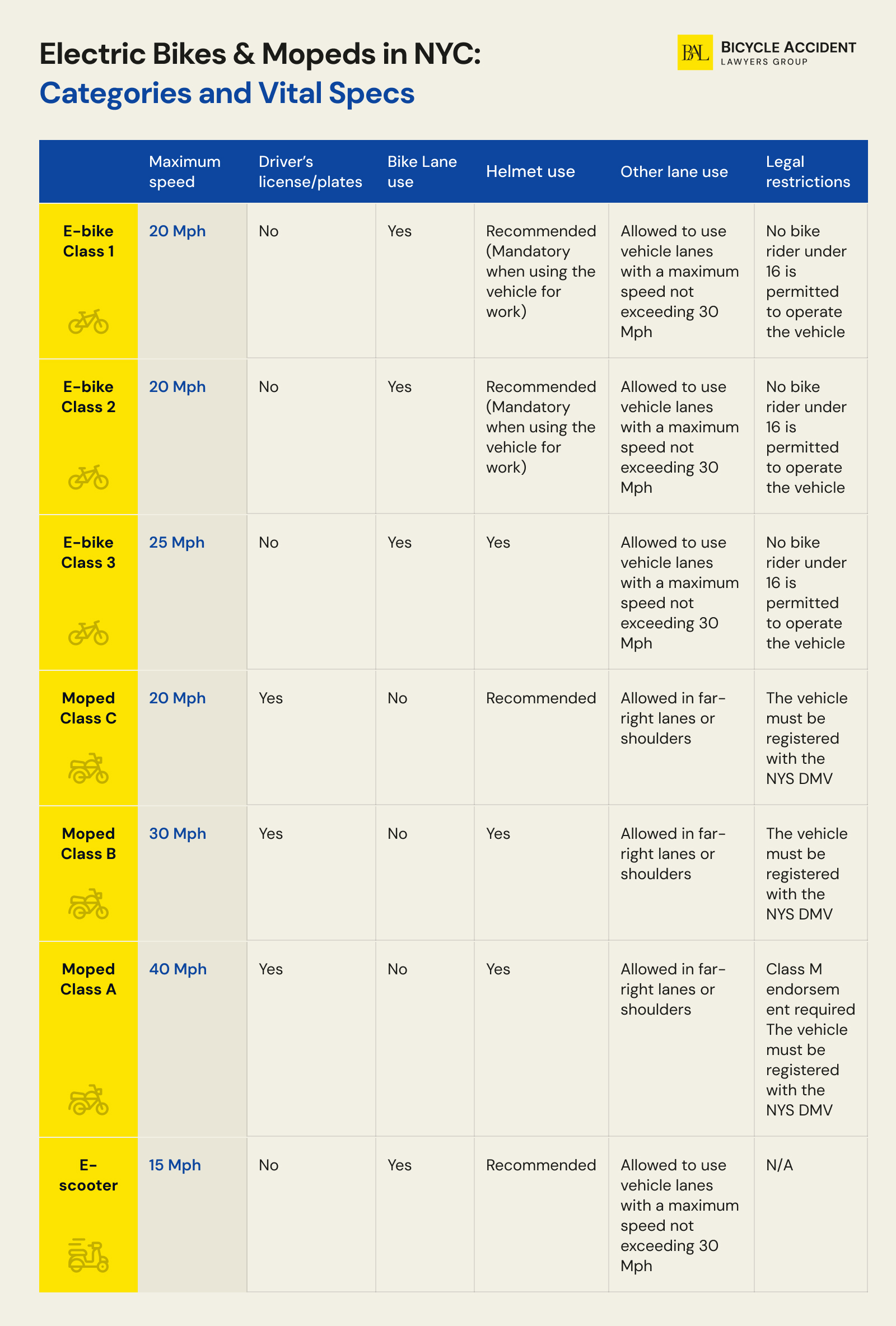
For an untrained eye, it may seem that all electric bikes differ only in terms of design. However, the truth is far from being that simple. There are different classes of e-bikes. Moreover, various NY cycling laws apply to each category, not to mention the fact that there are also electric scooters, mopeds, and motorcycles to distinguish between.
Each type and class of vehicle has specific requirements when it comes to maximum speed, helmet use, driver’s license, and potential legal restrictions. Our experts have compiled the existing electric bike laws into a single table so that you can spot the difference without effort and remain aware of your rights when operating an electric-powered vehicle on the streets of New York City.
| E-bike Class 1 |
E-bike Class 2 |
E-bike Class 3 |
Moped Class C |
Moped Class B |
Moped Class A |
E-scooter | |
| Maximum speed | 20 Mph | 20 Mph | 25 Mph | 20 Mph | 30 Mph | 40 Mph | 15 Mph |
| Driver’s license/plates | No | No | No | Yes | Yes | Yes | No |
| Bike Lane use | Yes | Yes | Yes | No | No | No | Yes |
| Helmet use | Recommended (Mandatory when using the vehicle for work) | Recommended (Mandatory when using the vehicle for work) | Yes | Recommended | Yes | Yes | Recommended |
| Other lane use | Allowed to use vehicle lanes with a maximum speed not exceeding 30 Mph | Allowed to use vehicle lanes with a maximum speed not exceeding 30 Mph | Allowed to use vehicle lanes with a maximum speed not exceeding 30 Mph | Allowed in far-right lanes or shoulders | Allowed in far-right lanes or shoulders | Allowed in far-right lanes or shoulders | Allowed to use vehicle lanes with a maximum speed not exceeding 30 Mph |
| Legal restrictions | No bike rider under 16 is permitted to operate the vehicle | No bike rider under 16 is permitted to operate the vehicle | No bike rider under 16 is permitted to operate the vehicle | The vehicle must be registered with the NYS DMV | The vehicle must be registered with the NYS DMV | Class M endorsement required
The vehicle must be registered with the NYS DMV |
N/A |
E-Bike Class 1
Class 1 electric bikes are very similar to traditional human-powered vehicles — you have to pedal to keep moving. However, the electric motor that the bicycle is equipped with will help you do it so that there is less strain on the rider. The maximum speed of this class of e-bikes is 20 mph, meaning that the assistance will stop when you try to exceed the speed limit.
E-Bike Class 2
Unlike Class 1 vehicles, electric bicycles of Class 2 can keep moving when the cyclist isn’t pedaling. However, it has the same speed limit, which ensures that the throttle stops when you go over 20 mph.
E-Bike Class 3
This is the fastest class of electric bike. The make is designed to be operable in both pedalling and throttle modes. The pedal-assist variations can’t go over 25mph. A throttle-assist mechanism won’t function if a bike rider decides to go over 20 mph in the mode.
What Is the Top Speed Limit for Electric Bikes in New York?
Both Class 1 and Class 2 electric bikes have the same top speed limit — 20 miles per hour. Class 3 e-bikes can go up to 28 miles per hour, but in New York City, only a 25-mile-per-hour limit is deemed legal. These speed regulations ensure that the vehicles are equally safe to operate on bike paths as well as other roads.
Keep in mind that electric vehicles that have been modified are illegal to operate on the streets. Failing to comply with these rules can seriously impact your chances of receiving a fair bicycle accident settlement in NYC if an incident occurs. To make sure you handle everything correctly, it’s important to know exactly what to do after a bicycle accident in New York to protect your rights and strengthen your potential claim.
What Are Other Major Operating Requirements for Electric Bicycle Riders in New York?
Local electric bike laws in New York do not require an additional operating license for any class of e-bike. Class 1 and Class 2 riders aren’t required to wear helmets unless on duty, though it’s strongly recommended. Class 3 operators, however, must wear helmets at all times due to higher speed limits. Riders must also be at least 16 years old to operate any electric bicycle. Following these regulations is not only important for safety but can also significantly impact the average bicycle accident settlement in NYC if a crash occurs.
Operable Pedal Requirements
Even though some classes of electric bikes can be fully propelled by the motors that they are equipped with, they must feature operable pedals. An e-cyclist has to be able to ride the bike the way they would a regular bicycle. Why does it matter?
Primarily because such a vehicle does not require a license or DMV registration to be legally operated. Moreover, pedals ensure that the rider has better control of the vehicle should an emergency appear. Lastly, if a rider gets into an accident and their electric bike isn’t equipped with functional pedals, they may be held liable for the collision, and it will affect their right to fair compensation.
Critical E-Bike Helmet Laws to Comply with in New York
Any field-trained New York bicycle accident attorney would tell you that electric bikes aren’t all about speed and convenience. You must ensure enhanced individual protection when riding an electric bicycle, and a protective helmet can help you succeed. Even though adult riders operating Class 1 and 2 e-bikes aren’t required to wear headgear, all riders operating Class 3 must invest in protective gear to navigate the streets legally.
Other helmet laws apply to people who use Class 1 and 2 electric bikes for work, such as delivery service riders. They are legally mandated to wear helmets during work hours.
Conclusion
An electric bike is among the innovative means of transportation that are gaining popularity as we speak. Despite the obvious advantages of these vehicles, there are potential drawbacks in the form of safety concerns. If you are set on using this fast, convenient, and eco-friendly type of transport in New York, you must operate it with caution and comply with all the existing laws and regulations. Should you get involved in an incident while riding an electric bike in NYC, contact our team for a free consultation and unparalleled legal assistance!
If you’re a cyclist who has been in an accident, call today for a free initial consult about your legal claim. We’re here to help with your legal questions. Contact our law firm for coast-to-coast bike accident and personal injury representation.

Get answers to commonly asked questions about our legal services and learn how we may assist you with your case.
What Is the Max Speed an Electric Bike Can Go?
The maximum speed of an electric bike is predefined by its class. Classes 1 and 2 can’t go over 20 mph, while Class 3 bikes can develop riding speeds up to 25 miles per hour. Exceeding either speed limit can lead to various implications in the form of physical injuries, financial strain, and legal problems.
Are E-Bikes Legal in New York?
There are three legal types of electric bicycles in New York: Class 1, Class 2, and Class 3. Each class should feature necessary equipment, including but not limited to operable pedals, state-approved electric motors, lights, and reflectors.
What to Do If I Get Injured in an E-Bike Accident in New York?
The most important things to do if you get in a biking accident would be to prioritize your safety and legal rights. That is why you should always notify law enforcement about the incident, get yourself checked by a trained medic, and contact a personal injury lawyer for immediate consultation.


